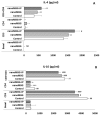Osteoimmune Properties of Mesoporous Bioactive Nanospheres: A Study on T Helper Lymphocytes
- PMID: 37570501
- PMCID: PMC10421130
- DOI: 10.3390/nano13152183
Osteoimmune Properties of Mesoporous Bioactive Nanospheres: A Study on T Helper Lymphocytes
Abstract
Bioactive mesoporous glass nanospheres (nanoMBGs) charged with antiosteoporotic drugs have great potential for the treatment of osteoporosis and fracture prevention. In this scenario, cells of the immune system are essential both in the development of disease and in their potential to stimulate therapeutic effects. In the present work, we hypothesize that nanoMBGs loaded with ipriflavone can exert a positive osteoimmune effect. With this objective, we assessed the effects of non-loaded and ipriflavone-loaded nanoparticles (nanoMBGs and nanoMBG-IPs, respectively) on CD4+ Th2 lymphocytes because this kind of cell is implicated in the inhibition of osseous loss by reducing the RANKL/OPG relationship through the secretion of cytokines. The results indicate that nanoMBGs enter efficiently in CD4+ Th2 lymphocytes, mainly through phagocytosis and clathrin-dependent mechanisms, without affecting the function of these T cells or inducing inflammatory mediators or oxidative stress, thus maintaining the reparative Th2 phenotype. Furthermore, the incorporation of the anti-osteoporotic drug ipriflavone reduces the potential unwanted inflammatory response by decreasing the presence of ROS and stimulating intracellular anti-inflammatory cytokine release like IL-4. These results evidenced that nanoMBG loaded with ipriflavone exerts a positive osteoimmune effect.
Keywords: ipriflavone; lymphocytes; mesoporous bioactive glass; nanospheres; osteoimmunology; osteoporosis.
Conflict of interest statement
The authors declare no conflict of interest.
Figures









Similar articles
-
Ipriflavone-Loaded Mesoporous Nanospheres with Potential Applications for Periodontal Treatment.Nanomaterials (Basel). 2020 Dec 21;10(12):2573. doi: 10.3390/nano10122573. Nanomaterials (Basel). 2020. PMID: 33371499 Free PMC article.
-
Effects of Ipriflavone-Loaded Mesoporous Nanospheres on the Differentiation of Endothelial Progenitor Cells and Their Modulation by Macrophages.Nanomaterials (Basel). 2021 Apr 24;11(5):1102. doi: 10.3390/nano11051102. Nanomaterials (Basel). 2021. PMID: 33923311 Free PMC article.
-
Incorporation and effects of mesoporous SiO2-CaO nanospheres loaded with ipriflavone on osteoblast/osteoclast cocultures.Eur J Pharm Biopharm. 2018 Dec;133:258-268. doi: 10.1016/j.ejpb.2018.10.019. Epub 2018 Oct 29. Eur J Pharm Biopharm. 2018. PMID: 30385420
-
Interaction between bone and immune cells: Implications for postmenopausal osteoporosis.Semin Cell Dev Biol. 2022 Mar;123:14-21. doi: 10.1016/j.semcdb.2021.05.014. Epub 2021 May 20. Semin Cell Dev Biol. 2022. PMID: 34024716 Review.
-
[Ipriflavone].Nihon Rinsho. 1998 Jun;56(6):1537-43. Nihon Rinsho. 1998. PMID: 9648478 Review. Japanese.
References
-
- Arcos D., Gómez-Cerezo N., Saiz-Pardo M., de Pablo D., Ortega L., Enciso S., Fernández-Tomé B., Díaz-Güemes I., Sánchez-Margallo F.M., Casarrubios L., et al. Injectable mesoporous bioactive nanoparticles regenerate bone tissue under osteoporosis conditions. Acta Biomater. 2022;151:501. doi: 10.1016/j.actbio.2022.07.067. - DOI - PubMed
LinkOut - more resources
Full Text Sources
Research Materials

